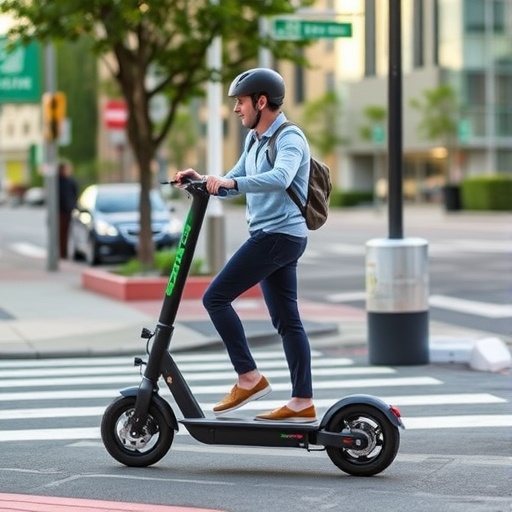A recent groundbreaking study conducted by researchers at the University of Illinois Urbana-Champaign has unveiled profound and unexpected effects of the burgeoning shared electric scooter (e-scooter) phenomenon on urban mobility patterns and public safety dynamics. The investigation, spearheaded by Dr. Unnati Narang, a prominent marketing professor at the Gies College of Business, meticulously analyzed data collected from Chicago’s widespread introduction of e-scooters during the summer of 2019. This research challenges prevailing narratives that uniformly celebrate e-scooters as environmentally friendly innovations that seamlessly integrate into existing transportation networks.
The researchers deployed a robust statistical framework known as the generalized synthetic control method to dissect comprehensive datasets comprising over eight million rideshare trips, approximately 750,000 bikeshare trips, and granular crime reports spanning 866 census tracts in Chicago. Such a detailed approach allowed for the examination of both pre- and post-introduction mobility trends across a 41-week timeline, capturing nuanced shifts in consumer behavior and public safety metrics within areas granted e-scooter access compared to demographically and spatially comparable neighborhoods lacking such access.
One of the most startling discoveries of the study was that the advent of shared e-scooters catalyzed a significant 15.7% increase in short-distance rideshare trips. This suggests a category expansion effect where e-scooters not only enable new trips that might not have otherwise been undertaken but often foster multimodal journeys combining scooter rides with subsequent rideshare vehicle usage. For instance, an individual could scooter to a dining establishment and later use a rideshare service to return home. This complex interplay indicates that e-scooters augment urban mobility by stimulating demand within adjacent transportation categories rather than operating in isolation.
Conversely, bikeshare programs experienced a 7.6% decrease in trip volumes in neighborhoods where e-scooters were introduced. This inverse relationship highlights a cannibalization effect, where the availability of e-scooters directly substitutes for bikeshare usage, likely due to overlapping trip purposes and user demographics. The findings challenge the assumption that all forms of micro-mobility inherently complement each other and emphasize the necessity for transit planners to acknowledge potential internal competition within shared mobility ecosystems.
While the expansion of shared mobility options presents clear economic opportunities—evidenced by $8.1 million in rideshare revenues associated with rented e-scooters—the study also uncovered less visible but critical social externalities. There was a concurrent 17.9% increase in reported crimes, specifically street and vehicle-related offenses including thefts and car break-ins, in e-scooter accessible areas. This correlation raises important questions about the unintended consequences of deploying fast, portable vehicles that might be exploited in opportunistic criminal activities.
The spatial distribution of these effects was notably uneven across Chicago’s diverse neighborhoods. Areas characterized by higher proportions of minority residents saw disproportionate rises in rideshare demand but also bore a heavier burden of crime increases. In contrast, lower-minority neighborhoods exhibited stronger substitution effects favoring bikeshare over scooters. Such disparities underscore how the roll-out of seemingly universal innovations can exacerbate existing urban inequities, posing challenges for equitable urban policy design.
Age demographics further modulated these impacts, with younger communities experiencing a dramatic 20.6% uptick in crime rates post e-scooter introduction, a figure substantially higher than in older neighborhoods. This trend may be reflective of sociocultural factors, usage patterns, or differential enforcement and surveillance, suggesting that demographic context critically mediates the balance of benefits and risks associated with shared e-scooter systems.
Environmental implications, despite being a key rationale for widespread e-scooter promotion, also warrant reconsideration in light of these findings. Rather than substituting for less carbon-intensive transit methods, e-scooters appear to stimulate additional short rideshare trips that cumulatively increase carbon emissions by over 800 metric tons annually in Chicago alone. This net-negative environmental impact starkly contrasts the green image often associated with e-scooters and calls for integrated lifecycle emission assessments in urban mobility planning.
The researchers emphasize that compensating for these emissions would require extensive ecological mitigation, such as planting approximately 36,000 trees to absorb equivalent carbon over a one-year period. These calculations and trade-offs illuminate the complexities inherent in adopting new transportation technologies and underscore the importance of holistic evaluations that extend beyond immediate consumer convenience and economic metrics.
In light of these multifaceted consequences, urban policymakers are urged to develop more nuanced regulatory frameworks governing e-scooter deployments. Recommended measures include the design and installation of protected lanes to enhance user safety, targeted public safety campaigns to mitigate crime opportunities, and strategic rollouts that engage directly with affected communities to ensure equitable benefit distribution. Such proactive governance is positioned as essential to harnessing the benefits of e-scooters while minimizing their social and environmental costs.
To facilitate evidence-based decision-making, Dr. Narang and her colleagues developed an interactive research application. This user-friendly tool enables policymakers and residents to model potential impacts of e-scooter rollouts within their own zip codes, predicting changes in transportation usage and crime patterns based on the study’s empirical findings. Moreover, the app features an AI agent to assist users in exploring data and understanding projections, promoting transparency and community participation in urban mobility planning.
This pioneering research, soon to be published in the prestigious Journal of Marketing, punctuates the critical need for comprehensive evaluation of shared mobility innovations. It dismantles uncritical assumptions about e-scooter benefits, instead revealing a complex landscape where new technologies simultaneously reshape transportation, economic activity, social equity, and public safety. Going forward, these insights offer a roadmap for cities worldwide to balance innovation with inclusivity and sustainability in the evolution of urban transit.
Subject of Research: People
Article Title: “How E-Scooters Impact Shared Mobility and Consumer Safety”
News Publication Date: 23-Oct-2025
Web References:
https://e-scooter.shinyapps.io/e-scooter/
http://dx.doi.org/10.1177/00222429251393987
Image Credits: Photo by Gies College of Business
Keywords: Streets, Transportation infrastructure, Transportation engineering




